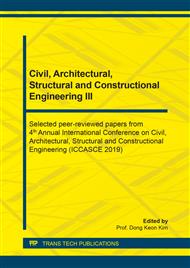p.56
p.61
p.68
p.73
p.78
p.85
p.91
p.98
p.106
Mechanical Properties of ECC Incorporating Low-Cost PVA Fibers
Abstract:
This research aims to investigate the mechanical properties of engineered cementitious composites including compressive strength, splitting tensile strength, modulus of rupture, and load-deflection behavior. In addition, the abrasion test of concrete under water, which is recommended by ASTM C1138, was carried out and its results were compared with the splitting and modulus of rupture test results. Untreated low-cost polyvinyl fibers were used with different volume fractions of 0.5, 1.0, 1.5, and 2.0%. All tests were carried out at the standard age of 28 days. The experimental results showed that the use of 2% of low cost polyvinyl fibers with the engineered cementitious composites led to the increase of the splitting tensile strength and the modulus of rupture by 134% and 287%, respectively, compared to specimens incorporating no fibers. The results showed also that the deflection and the ultimate failure load increases as the fiber content increase.
Info:
Periodical:
Pages:
78-84
Citation:
Online since:
April 2020
Authors:
Keywords:
Price:
Сopyright:
© 2020 Trans Tech Publications Ltd. All Rights Reserved
Share:
Citation:


